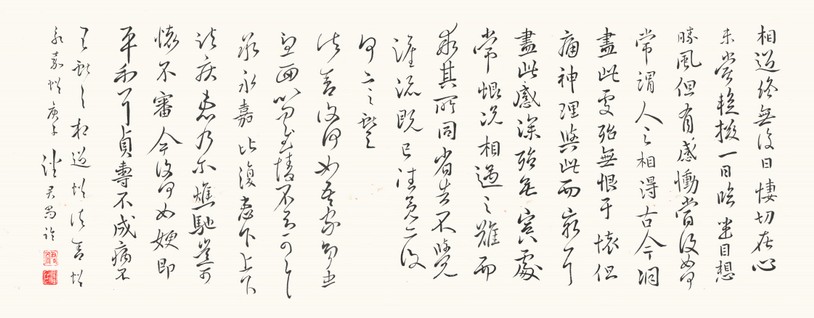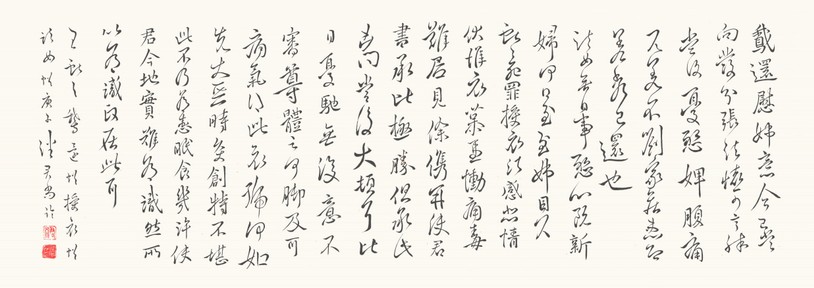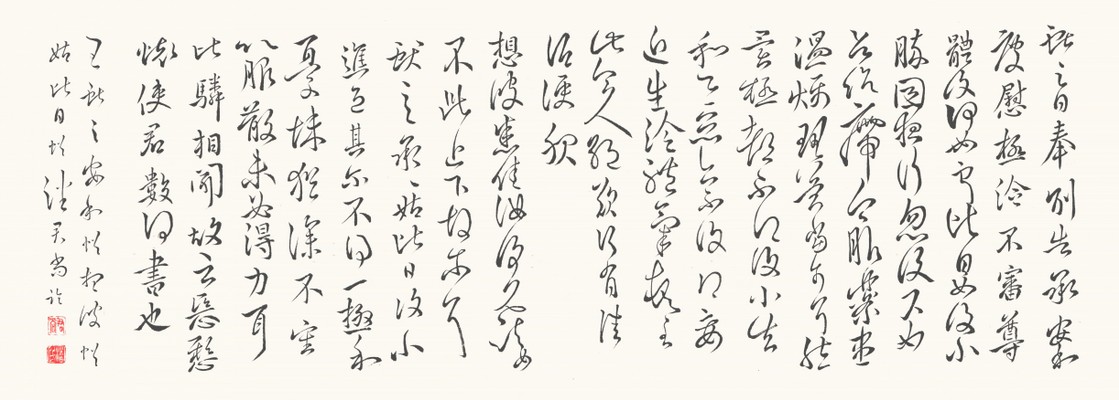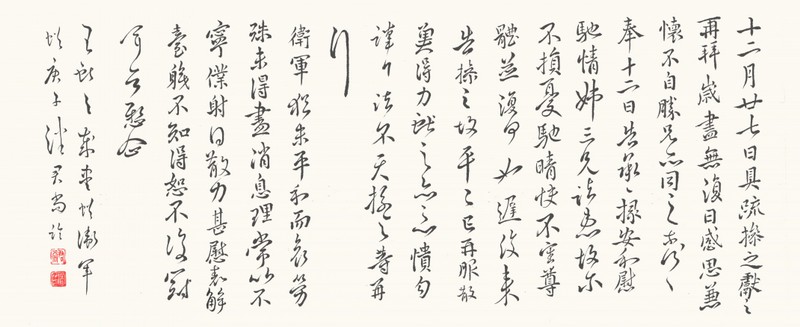Galleries and Translations > Models of Masterpieces > Models of Masterpieces by Wang Xianzhi (part I) 臨王獻之諸法帖 (第一部份)
Models of miscellaneous Exemplary Masterpieces by Wang Xianzhi (part I) 臨王獻之諸法帖 (第一部份)
Historical information
(I)
Wang Xianzhi (王獻之, 344-386AD) was the seventh son of “The Sage of Calligraphy (書聖)” Wang Xizhi (王羲之, 303–361AD). At an early age of seven, his extraordinary talents in calligraphy had already been recognized by his father (七八歲時學書,羲之密從後掣其筆不得,歎曰:「此兒後當復有大名。」)(1). Although he later developed a rather unrestraint and unconventional personality (高邁不羈…風流為一時之冠) (2), his cursive and standard scripts were widely admired (工草隸)(3) for their liberating and serene demeanours (逸氣縱橫)(4). Thus, along with his father, he was regarded as one of the Four Talents (四賢) in the art of Chinese calligraphy(5).
(II)
Despite Wang Xianzhi’s brilliance, his calligraphy was not without criticism. The Book of Jin narrated that his calligraphy lacked strength and sturdiness compared to that of his father (獻之骨力遠不及父)(6). Sun Guoting, in his Narrative on Calligraphy, went even further to chastized his arrogance and thus concluded that his art was undoubtedly inferior to his father’s (子敬之不及逸少,無或疑焉)(7). Such criticisms serve as good reminders that the ultimate foundation of Chinese calligraphy is the refinement of temperaments, not techniques(8).
(III)
The calligraphies presented below are my models of Wang Xianzhi's handwriting found in Chunhua Imperial Archive of Calligraphy Exemplars (《淳化閣帖》). Supposedly, these handwritings were short letters and memos scribed by Wang. Although their authenticities are questionable, they are still often regarded as Exemplary Masterpieces (法帖) for calligraphers to study and observe. In the art of Chinese calligraphy, "帖(pronounced as Tie)" refers to an exemplary work that should be studied by all .
(IV)
Since the originals in the Chunhua Imperial Archive of Calligraphy Exemplars (《淳化閣帖》) can be parts of or whole letters/memos scribed by Wang, translations that are provided below, if available, may not be entirely precise, for they can be interpreted out of context. Further, whether Wang had actually scribed them remains questionable. Accordingly, scholars should be wary of using these as authentic historical references.
____________________________________________
(1) 房玄齡,《晉書》卷八十王羲之列傳. 北京:中華書局, 1974, p.2105.
(2) Ibid., p.2104.
(3) Ibid., p.2104.
(4) 張懷瓘《書斷》. 《歷代書法論文選》. 上海: 上海書畫出版社, 1979, p.164.
(5) KS Vincent Poon & Kwok Kin Poon, A Narrative on Calligraphy by Sun Guoting Revised and Enhanced Edition 英譯書譜 增訂版. Toronto: The SenSeis, 2019, pp.9-10.
(6) 房玄齡,《晉書》卷八十王羲之列傳. 北京:中華書局, 1974, p.2106.
(7) KS Vincent Poon & Kwok Kin Poon, A Narrative on Calligraphy by Sun Guoting Revised and Enhanced Edition 英譯書譜 增訂版. Toronto: The SenSeis, 2019, p.15.
A model of Xiang Ying Tie (相迎帖), Zhu She Tie (諸舍帖), and Yong Jia Tie (永嘉帖)
35 X 90 cm
Click to Enlarge. Reserved, not available in shop.
Xiang Ying Tie (相迎帖):
Original Classical Chinese: 相迎終無復。日淒切在心未嘗蹔撥。一日臨坐,目想勝風,但有感慟。當復如何? 常謂人之相得,古今洞盡此處,殆無恨于懷。但痛神理與此而窮耳。盡此感深,殆無寘處。常恨!況相遇之難,而乖其所同。省告,不覺灌流,既已往矣,亦復何言。獻之。
English: NA. The entire phrase may not be translated, for the context in which it was written is unknown or uncertain.
Zhu She Tie (諸舍帖):
Original Classical Chinese: 諸舍復如何,吾家多患憂。面以問慰,情不知可耳。
English: NA. The entire phrase may not be translated, for the context in which it was written is unknown or uncertain.
Yong Jia Tie (永嘉帖):
Original Classical Chinese: 承永嘉。比復患下。上下諸疾患。乃爾燋馳。豈可懐不審。今復何如。㛐即平和耳。貞夀不成病不。
English: NA. The entire phrase may not be translated, for the context in which it was written is unknown or uncertain.
A model of E Hai Tie (鵞還帖), Zhu Nu Tie (諸女帖), and Shou Yi Tie (授衣帖)
35 X 99 cm
Click to Enlarge. Reserved, not available in shop.
E Hai Tie (鵞還帖):
Original Classical Chinese: 鵞還慰姉。意今已當向發分張。諸懐可言殊。當復憂懸。婢腹痛見差不。劉家疾患即差。秀已還也。
English: NA. The entire phrase may not be translated, for the context in which it was written is unknown or uncertain.
Zhu Nu Tie (諸女帖):
Original Classical Chinese: 諸女無白事,懸心。阮新婦,何日至慰姉目下。
English: NA. The entire phrase may not be translated, for the context in which it was written is unknown or uncertain.
Shou Yi Tie (授衣帖):
Original Classical Chinese: 獻之死罪。授衣諸感悲情。伏惟,哀慕兼慟,痛毒難居。見徐儁并使君書,承比極勝。但承此凶問,當復大頓耳。比日憂馳無復意。不審尊體云何,腳及可痛氣,得此哀號。何如。先大惡時,灸創特不堪。此不乃為患。眼食幾許。使君今地,實難為識。然所以為識政在此耳
English: NA. The entire phrase may not be translated, for the context in which it was written is unknown or uncertain.
A model of An He Tie (安和帖), Xiang Bi Tie (想彼帖), and Gu Bi Ri Tie (姑比日帖)
35 X 98 cm
Click to Enlarge. Reserved, not available in shop.
An He Tie (安和帖):
Original Classical Chinese: 獻之白,奉別告。承安和,慶慰。極冷。不審尊體復何如。獻之比日如復小勝。因夜行忽復下。如欲作㿃。今服藥,盡温燥理。冀當可耳。然異極都不得,復小失和。卿惡亦不復得妄近生冷。體氣頓至此,令人絶歎。行有佳酒便服。
English: NA. The entire phrase may not be translated, for the context in which it was written is unknown or uncertain.
Xiang Bi Tie (想彼帖):
Original Classical Chinese: 想彼悉佳。汝復見諸女不。此近下故爾耳。
English: NA. The entire phrase may not be translated, for the context in which it was written is unknown or uncertain.
Gu Bi Ri Tie (姑比日帖):
Original Classical Chinese: 獻之白。承姑比日復小進退。其爾不得一極和。憂悚猶深。不審以服散。未必得力耳。比驎相聞。故云惡。懸懐使君數得書也。
English: NA. The entire phrase may not be translated, for the context in which it was written is unknown or uncertain.

A model of Si Lian Tie (思戀帖), Jie Guo Sui Zhong Tie (節過嵗終帖), Yuan Yu Tie (願餘帖), and Shi Feng Tie (適奉帖)
35 X 108 cm
Click to Enlarge. Reserved, not available in shop.
Si Lian Tie (思戀帖):
Original Classical Chinese: 獻之白。思戀觸事彌至。獻之既欲過餘杭州。將若比還京,必視之。來月十左右便當發。奉見無復日。比告何喻。願復盡珍重理。獻之白。
English: NA. The entire phrase may not be translated, for the context in which it was written is unknown or uncertain.
Jie Guo Sui Zhong Tie (節過嵗終帖):
Original Classical Chinese: 獻之白。節過嵗終,衆感纒心。伏惟同之。奉月初告。承極不平復,頭眼半體疹恒惡。兄告說。姉故殊黄瘦。憂馳可言。寒切。不審尊體復何如。眠食轉進不。氣力漸復先耳。遲復旨告。獻之故爾。獻之白。
English: NA. The entire phrase may not be translated, for the context in which it was written is unknown or uncertain.
Yuan Yu Tie (願餘帖):
Original Classical Chinese: 願餘上下安和。知婢日夕疏慰意。育故羸。懸心。倪比健也。
English: NA. The entire phrase may not be translated, for the context in which it was written is unknown or uncertain.
Shi Feng Tie (適奉帖):
Original Classical Chinese: 適奉永嘉去月十二日動靜。故常患不寜。諸女無復消息。獻之白。
English: NA. The entire phrase may not be translated, for the context in which it was written is unknown or uncertain.
A model of Sui Jin Tie (嵗盡帖) and Wei Jun Tie (衛軍帖)
35 X 86 cm
Click to Enlarge. Reserved, not available in shop.
Sui Jin Tie (嵗盡帖):
Original Classical Chinese: 十二月廿七日。具疏。操之,獻之再拜。嵗盡無復日。感思兼懐不自勝。兄亦同之。奈何奈何。奉十二日告。承承掾安和。慰馳情。姉三兄諸患故爾不損。憂馳。晴快。不審尊體並復何如。遲復來告。操之故平平。已再復散。冀得力。獻之亦惡憒勿。謹白。諸不具。操之等再拜。
English: NA. The entire phrase may not be translated, for the context in which it was written is unknown or uncertain.
Wei Jun Tie (衛軍帖):
Original Classical Chinese: 衛軍猶未平和而哀勞。殊未得盡消息理。常以不寜。僕射得散力,甚慰,表解臺職。不知得恕不。復冠軍。告懸企。
English: NA. The entire phrase may not be translated, for the context in which it was written is unknown or uncertain.



